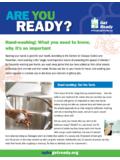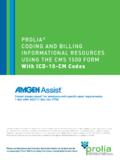Transcription of INFLUENZA ICD-9 487; ICD-10 J09, J10, J11 I. …
1 When the child ingests fleas that, in their larval stage, have eaten eggs fromproglottids. In 3 4 weeks the tapeworm becomes mature. Infection isprevented by keeping dogs and cats free of fleas and worms; treatment asforH. nana. INFLUENZAICD-9 487; ICD-10 J09, J10, J11I. SEASONAL INFLUENZA ICD-9 487; ICD-10 J10, J11[CCDM19: C. B. Bridges, A. Fry, K. Fukuda, N. Shindo][CCDM18: K. Sto hr]1. Identification An acute viral disease of the respiratory tractcharacterized by fever, cough (usually dry), headache, myalgia, prostra-tion, coryza, and sore throat. Cough is often severe and can last 2 or moreweeks; fever and other symptoms generally resolve in 5 7 days. Intemperate climates, recognition is commonly based on clinical presenta-tion during winter months with a syndrome consistent with improves when INFLUENZA surveillance information is available toindicate INFLUENZA viruses are in circulation.
2 INFLUENZA may be clinicallyindistinguishable from disease caused by other respiratory viruses, such asrhinovirus, RSV, parainfluenza, adenovirus and other pathogens. Syn-dromes consistent with INFLUENZA include acute upper respiratory illness,croup, bronchiolitis, febrile seizures, and pneumonia. In children, GI tractmanifestations (nausea, vomiting, diarrhea) may accompany the respira-tory phase, and have been reported in up to 25% of children in schooloutbreaks of INFLUENZA B and A (H1N1). GI manifestations are uncommonin adults. Infants may present with a sepsis-like syndrome. Older adultswith INFLUENZA can present with worsening of underlying conditions suchas congestive heart failure, and may not have an elevated rapid testing is increasingly available to assist with diagno-sis.
3 Such tests are useful especially in rapidly establishing INFLUENZA as thebasis for out-of-season outbreaks or outbreaks in remote areas wherespecimen transportation takes time. Such information can enable timelyimplementation of control measures. Commercially available point-of-caretests are generally 70% or less sensitive, but approximately 95% , particularly in the setting of a known INFLUENZA epidemic, negativeresults from patients with symptoms consistent with INFLUENZA must beinterpreted cautiously. If excluding a false-negative result is important,then more sensitive testing should be considered, including viral cultureand RT-PCR seasonal INFLUENZA epidemics impose a substantial health burdenon all age groups, but the highest risk of complications occur amongchildren less than 2 years, adults older than 64 years, and persons of anyage with certain medical conditions, including chronic cardiovascular, INFLUENZA / 315pulmonary, renal, hepatic, hematologic or metabolic disorders ( dia-betes); immunosuppression; pregnancy; and neurologic/neuromuscularconditions that can compromise respiratory function or handling ofrespiratory secretions.
4 Secondary complications of INFLUENZA include bac-terial pneumonia, including co-infection with MRSA and S. pneumonia;viral pneumonia; worsening of underlying conditions; sinusitis; otitismedia; febrile seizures; encephalitis/encephalopathy; myositis; and Reyesyndrome in association with use of salicylates. Although seasonal influ-enza deaths can occur in any age group, over 90% of INFLUENZA deathsoccur among those aged 65 years and older. Annual epidemics of influenzacan be explosive and overwhelm health care studies of the epidemiology of INFLUENZA have been conducted indeveloped countries in temperate climates, but more information is nowbeing obtained from developing and tropical countries that have foundhigher risk of INFLUENZA complications and death among children less than5 years, the elderly, and those with chronic diseases.
5 Reports of influenzaoutbreak investigations in Africa and Indonesia suggest malnutrition andpoor access to health care are likely to contribute to higher rates ofcomplications and confirmation of INFLUENZA infection can be done by isolationof viruses from throat, nasal, and nasopharyngeal secretions or trachealaspirate or washings using cell culture or in embryonated eggs; directidentification of viral antigens in nasopharyngeal cells and fluids (FA test orELISA); rapid diagnostic tests; or viral RNA amplification. Demonstration ofa 4-fold or greater rise in specific antibody titer between acute andconvalescent sera can also be used to confirm acute infection.
6 Singleserological specimens cannot be used to diagnose an acute , respiratory specimens should be collected as early in the illness aspossible. Virus shedding starts to wane by the 3rd day of symptoms, andin most cases virus is not detected after 5 days in adults, though virusshedding can occur longer in Infectious agents Three types of seasonal INFLUENZA virus arerecognized: A, B and C. The antigenic properties of the two relativelystable internal structural proteins, the nucleoprotein and the matrixprotein, determine virus type. INFLUENZA A viruses are further divided intosubtypes based on two viral surface glycoproteins: the hemagglutinin (H)and the neuraminidase (N).
7 There are 16 different hemagglutinin subtypesand 9 different neuraminidase subtypes. The current subtypes of influenzaA viruses circulating widely among humans are A (H1N1) and A (H3N2).Aquatic birds are the primary reservoir for INFLUENZA A viruses and allsubtypes of INFLUENZA A have been found among birds. INFLUENZA A virusesalso circulate among other animals, including pigs, horses, seals, and otheranimals. INFLUENZA B viruses are not divided into subtypes, but twoantigenically distinct lineages of B viruses currently circulate amonghumans. Humans are the primary reservoir for INFLUENZA B. Both influenzaA and B viruses can be further classified into strains, and can causeseasonal316 / INFLUENZA outbreaks of INFLUENZA .
8 Only the emergence and spread of INFLUENZA A virusesbearing an H or H/N combination to which most personshave never beenexposed are known to cause pandemics. Type C INFLUENZA is associatedwith sporadic cases and minor localized outbreaks and imposes much lessof a disease burden than INFLUENZA A and B. Only INFLUENZA A and influenzaB viruses are included in seasonal INFLUENZA of antibody against the hemagglutinin are the most importantpredictor of protection against infection by human INFLUENZA against the neuraminidase can reduce the severity of encoding these surface glycoproteins are constantly changingthrough mutations, a process termed drift that occurs during virusreplication.
9 The constant emergence of new INFLUENZA strains through driftrequires the annual review and periodic replacement of vaccine , one or more strains are replaced in each year s vaccine. Theconstant emergence of new strains is the virologic basis for yearlyepidemics of seasonal INFLUENZA and one of the main reasons why multipleinfluenza infections can occur in an individual over their lifetime. Influ-enza virus strains are named based on their type, geographic site ofisolation, laboratory number, year of isolation, and subtype (for A virusesonly). Examples are A/New Caledonia/20/99(H1N1); A/Brisbane/10/2007(H3N2); and B/Malaysia/2506 Occurrence Seasonal INFLUENZA results in yearly epidemics ofvarying severity, with sporadic cases or outbreaks of human diseaseoccurring outside of typical seasonal patterns, and, rarely, as a attack rates during annual epidemics can range from 5% to 20% inthe general community to more than 50% in closed populations ( homes, schools).
10 During yearly epidemics in industrialized coun-tries, INFLUENZA illness often appears earliest among school-age highest illness rates generally occur in children, with accompanyingincreases in school absences, physician visits, and pediatric hospitaladmissions. INFLUENZA illness among adults is associated with increases inworkplace absenteeism, adult hospital admissions, and mortality, espe-cially among the elderly. In North America, epidemics generally last from8 10 weeks. One or more strains, subtypes and/or types of INFLUENZA cancirculate within a single INFLUENZA season in the same area. In temperatezones, epidemics tend to occur in winter months. In some tropicalcountries, INFLUENZA can occur year-round with 2 peaks per year consistentwith peak activity in Northern and Southern Hemisphere temperate zones,and/or peaks during the rainy Reservoir Humans are normally infected by human influenzaviruses (H3N2, H1N1 and B), and form the primary reservoir for thesehuman viruses.






